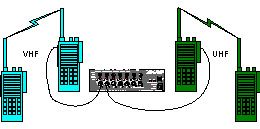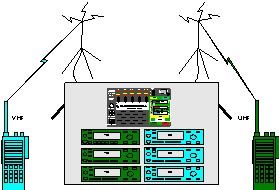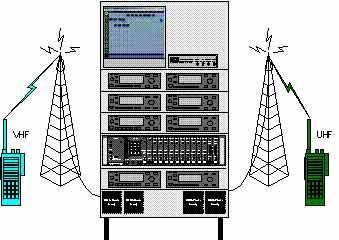By Capt. Eddie Reyes
Sponsored by Cisco Systems
Last month I mentioned the word “gateways” but did not really elaborate. I am sure some of you asked “What exactly is a gateway?” Well I am glad you asked because for the next few minutes I am probably going to tell you more about gateways than you would ever care to know. But for those who have a sincere interest in knowing a little more about this “tool,” get ready to read about my experience as the manager of one of the most robust gateway portfolios in the Mid-Atlantic Region.
I mention the word “tool” because that is exactly what gateways are, a tool in the toolbox of communications assets. A gateway is nothing more than a “gizmo” or a “black box” that allows the operator to connect several different radios (anywhere from 2 to 36, higher in some cases) together and allow first responders to talk with each other.
Today’s gateways have lots of functionality, such as being able to connect any device that produces an audio signal (voice) and pass that transmission (message) to any other device that is capable of receiving audio signals. Those audio devices include portable and mobile public safety radios, telephones (landline, cellular and satellite), the internet or a local area network (LAN), dispatch consoles, CB radios, family service radios, you get the hint.
When you consider all tools from a radio cache to standards-based radio systems, properly engineered gateways with trained operators are somewhere in the middle. They come in three distinct types:
- Portable – This type of gateway can be carried in a vehicle (back seat / trunk) and quickly deployed by attaching portable radios to it on the scene, mostly for line of sight communications. The Fire and EMS service seem to like this gateway a lot.
- Mobile – This type of gateway is normally installed (hard) in a command or communications vehicle, usually with mobile radios and fixed antennas on the roof. This type of gateway can achieve line of sight or repeated interoperable communications.
- Fixed – This type is normally hard mounted in an emergency communications center or antenna site with console or mobile radios, fixed antennas and normally operates in repeated mode.
But I must warn you, depending on whom you talk to, some people hate gateways and others love them. That is why I decided to call this month’s article – the Good, the Bad and the Ugly, because I will share with you my years of experience working on multiple gateway solutions.
I have found that some work great (good), some can be difficult to set up, operate and maintain (bad) and some can wreck havoc on a public safety agency’s radio system if not engineered properly or there is operator error (ugly). This is why some people hate them.
Keep in mind that most gateways are controlled by some computer component and they will normally do exactly what the operator tells them to do, so most bad experiences with gateways are the result of some human error. On the other hand, once properly set up, properly engineered and under the control of a trained operator, they can be a real life saver in the event of a major catastrophe requiring many first responders from multiple agencies who are using different radio systems. This is why some people love them. So let’s get started.
What are some current barriers to public safety interoperability? In other words, why do we need gateways in the first place? Well, for starters, public safety has to deal with incompatible and inadequate spectrum allocations or frequencies. That is, because there is a very finite amount of radio frequencies available to be used in any geographical area by public safety (and most of it is), we do the best that we can by using frequencies that are licensed to us without causing interference to any other frequency user out there. Have you ever stopped to think just how many radio users are really out there? Lots! I mean everyone from delivery drivers, taxi cabs and tow truck drivers to construction companies. They all have some type of private two-way radio on similar frequencies as public safety. Not to mention the cellular telephone providers that operate on some frequencies right next to the public safety spectrum.
Another reason to consider a gateway is there are limitations associated with the geographic coverage of most radio systems and today’s public safety leaders want to be able to talk whenever they have to, from wherever they are, using whatever type of device is in front of them. With traditional radio systems, usually you had to be within the coverage area of your agency’s radio system and have access to one of your agency’s radios if you wanted to listen or talk to someone on the other end. Today’s gateways have made this a thing of the past. With today’s gateways, it’s possible for example, for a chief of police on vacation in the mountains to talk with an incident commander on the perimeter of a hostage barricade situation involving the city manager when a cell phone is not one of the options available. In this scenario, if the chief has access to a secure computer with the proper software and hardware, he would be using radio over the Internet or Voice over Internet Protocol (ROIP). Literally, the sky is the limit today when it comes to public safety communications.
Finally, the most common barrier to public safety interoperability is not technical at all. It is the geo-political issues (politics and personal fiefdoms). There is a very common saying in the interoperability world that says: “Interoperability is 15% technical and 85% political” and it is true. Plain and simple, the real reason why some agencies still cannot talk with each other today is because egos and professional hatred have caused some department heads to decide they are not going to talk with each other even if technology allows it. I have been in meetings where a member of one law enforcement agency said no one should have the frequencies to his agency’s radio system, even though it is public information.
Some clear advantages include:
- Can be implemented without significant radio infrastructure modifications
- Capable of interconnecting multiple HF, VHF low band, VHF high band, UHF, 800 MHz 900 MHz radios
- Can include trunked talk-groups, encrypted networks, cell phones, satellite phones, and the public telephone network. The danger with encrypted interoperable connections is that it is possible for the gateway to pass the encrypted radio transmission to a radio that is connected to the gateway which is not encryption capable. Again, this would be caused by human error because the gateway is simply doing what the operator prompted it to do.
Like with any other technical or tactical equipment that your agency uses, operation of the gateway during non-emergency conditions requires:
- Regular maintenance. This is not as extensive as you may think. These devices are real work horses. They can be difficult to set up, but once they’re up and running properly, they require very little maintenance. The fixed gateway at my agency has been running continuously since 1999 with no major maintenance and continuous service. The most important feature to remember with the maintenance of mobile or fixed gateways is making sure the radio programming is maintained current. Often times an agency with a radio on a gateway will change frequencies or talk groups. When this occurs, the radio has to be upgraded to reflect this change.
- Routine testing with multiple agencies. It is much easier to accomplish with fixed gateways because all you have to do is sit in front of a work station and test a quick radio connection with another agency. Of course governance should be in place which dictates how and when training is conducted. Once a month is recommended for fixed gateways. At least biannually with the portable and mobile gateways if not used more often during real events. Documentation is vital for liability purposes.
- Readiness training. Spend the time and money to receive formal manufacturer training. Most training is anywhere from 8 to 24 hours and no one knows the equipment better than the manufacturer. With time, each agency will develop “power users” and these folks can then become the agency’s trainer if funds are limited.
Some gateway issues to be aware of include:
- Licensing for radios associated with gateway operations. The Federal Communications Commission (FCC) issues licenses for radios to be used in defined areas and gateways can consist of radios that operate outside of the licensed boundary but still remain within the region. While this is not a very serious issue because generally when these devices are used, it is for bonafide emergencies and the FCC has established regulations allowing the use of these radios outside of their licensed boundary during this condition. Yet, inadvertent connections or routine testing of these devices have caused formal groups, like the National Institute of Justice to have formal communication with the FCC to discuss this issue.
- Inadvertent operations. This occurs when an agency or operator is unaware that they have unintentionally connected a radio belonging to another agency which can cause the affected agency to lose its radio system, or a part of it for some time, until the error is located. In my region, several times, an agency’s gateway inadvertently connected two radio systems together which caused the affected agency to lose one of its primary operating channels for three days until the problem could be located. Governance will play a huge role in ensuring that these incidents never occur. It is very important that everyone in a region know exactly who has which device and who to contact in the event of an inadvertent incident.
- Un-coordinated operation (multiple links). This occurs when too many gateways show up at the scene and everyone fires theirs up simultaneously. Again, regional governance will play a huge role in ensuring this doesn’t occur. This is why it is vital to have effective human interaction ahead of time so when these devices start showing up, most communications unit leaders know each other and a thorough understanding occurs before any of the gateways are powered up. With the implementation of the National Incident Management System (NIMS), more and more each day, the formal recognition being given to the communications component will all but eliminate this potential. But nevertheless, you should be aware of it.
- Channel Loading. The gateway approach often requires a dedicated frequency (channel) for each of the interconnected radio systems throughout the duration of an incident. As a result proper planning is a must.
Portable Gateways:
 |
Used on a temporary basis to link two or more radios to create two or more separate radio conversations. For example, the agency using the VHF radios on the left would give up one radio to attach to the gateway while the other agency using the UHF radios on the right would also give up one radio to attach to the gateway. Now all the responding units on these two radio systems would be able to talk with each other. You can keep adding radios up to the gateway’s capacity. As I stated earlier, this configuration is a favorite of most fire and rescue departments because generally, they work a defined area, have a hard time reaching repeater sites from their portable radios inside blazing buildings and are quick and easy to set up. Using one of these configurations and the example cited above, two different fire companies could enter a building, using their own radios and talk with the incident commander. The real challenge with portable gateways is keeping the gateway powered and a charged battery on the portable radios attached to the gateway; this is why they are “temporary”. But most portable gateways can be powered by a 12 volt car battery, standard batteries such as AA or 120 volt electricity. And as long as you keep the batteries charged, the connection will remain intact. Obviously if the gateway loses power, all radios attached lose interoperability and if a portable radio loses power, that agency loses interoperability capability.
Mobile Gateways:
 |
While mobile gateways can also be used on a temporary basis to link two more radios to create two or more separate radio conversations, generally, these mobile gateways are more robust using mobile radios instead of portables, which can generally communicate with repeater sites with no problems. This type of configuration is generally hard mounted in a communications or command vehicle and as long as the vehicle has power, the gateway will have power. Antenna placement on the roof of the vehicle is always a challenge because radios will cause interference to each other when placed that close to each other. So it is highly recommended that a professional radio company engineer the antenna placement. The beauty of this configuration is once all the radio systems of agencies in your region are programmed into the mobile radios (VHF, UHF and 800 MHz); a trained operator can have many agencies talking quickly and seamlessly. But again, this requires lots of human interaction and cooperation. In addition to being in communications and command vehicles, some agencies have chosen to mount this equipment in a trailer so that if the vehicle fails, it can be towed by another. Sometimes all you need is additional communications capability and not the entire command vehicle, so a trailer has a good application there. If the vehicle has satellite and/or network capability, this type of gateway can allow you to broadcast the radio traffic at the scene back to any other location on the same network.
Fixed Gateways:
 |
The most robust of all gateway configurations. It can be used on either a permanent or a temporary basis to provide real-time on demand communication and interoperability. This configuration is usually installed in or near a 24x7 emergency communications center where it is always available to trained, on-duty personnel who can create an emergency connection between two or more radio systems instantly. These gateways will generally require a professional engineer because you will be dealing with lots of antenna placements on a tower or roofline, to include lightning suppressors. In the event you use mobile radios for interoperability on the rack (generally 19") there will be lots of power conversion from 120 volts to 12 volts in order to power these radios and a robust power inverter/power supply will be necessary, The real beauty with this configuration is it can be controlled from virtually anywhere using a personal computer. This type of configuration gives an agency so much interoperability potential, such as radio over IP which allows you to securely route your public safety communications system to any PC with the proper settings which can be located virtually anywhere on earth. It will allow you to create 2 to 20 (even more in some cases) different connections, that is, allow up to 20 separate conversations without interference to each other.
This can be important during major events where each component wants its own talk path – command, fire suppression, special weapons and tactics, inner and outer perimeter, etc. Finally, it allows for a dispatcher to dispatch to multiple units from multiple agencies without the units having to be connected to each other.
In closing, I hope I have given you a better understanding on the public safety communications gateway. Like I stated earlier, it can be a real asset to your communications arsenal if it is set up right and due diligence is given to training. But a poorly engineered gateway at the hands of person with no training can be a real disaster to public safety communications. Gateways are manufactured by many of the public safety communications vendors and vary in size from two radios in a backpack to many radios in a computer room. Other parts of the country, which have great success using these devices, include Los Angeles County, CA; Hawaii; Florida; Houston, TX and Danville, VA.
If you are serious about considering a gateway for your application, please remember the three R’s:
- Regular maintenance.
- Routine testing with multiple agencies.
- Readiness training.













